

Braquenié et Cie was a French fabric designer and manufacturer. The company was founded in 1823. [1]


Braquenié et Cie was a French fabric designer and manufacturer. The company was founded in 1823. [1]
The company was founded in 1823 by Pierre-Antoine Doineau and his wife Louise-Desirée Doineau. [2] Around 1840 the company opened a factory at Aubusson, France. [3] In 1842 the company renamed itself Demy-Doineau et Braquenié, Manufacture Royale de Tapis et de Tapisserie. [4] Two years later, Demy-Doineau et Braquenié exhibited at the French Industrial Exposition of 1844 in Paris. [4]
In 1858 the brothers Alexandre and Charles-Henri Braquenié took over the company, renaming it Braquenié frères; [2] [3] In 1873 this was changed to Braquenié et Cie. [4] In 1898 the company purchased land and a former fabric factory in Felletin, France. [3] [5]
Its clients included the Kings Louis-Philippe, Napoléon III and his wife Eugénie, the family Rothschild and the Vatican. [6]
Examples of their work are included in the collections of the Metropolitan Museum of Art, New York [2] and the National Gallery of Art, Washington. [7]
The factory at Felletin closed in 1958 or 1959. [3] Its factories at Malines and d'Aubusson closed in 1987 and 1990, respectively. [3] In 1991 the company and its designs were acquired by Pierre Frey. [5]

Aubusson is a commune in the Creuse department region in central France.

The Gobelins Manufactory is a historic tapestry factory in Paris, France. It is located at 42 avenue des Gobelins, near Les Gobelins métro station in the 13th arrondissement of Paris. It was originally established on the site as a medieval dyeing business by the family Gobelin.

Louis-Jean-François Lagrenée was a French rococo painter and student of Carle van Loo. He won the Grand Prix de Rome for painting in 1749 and was elected a member of the Académie royale de peinture et de sculpture in 1755. His younger brother Jean-Jacques Lagrenée was also a painter.
The A.M. was a range of automobiles manufactured by the French firm of Ateliers Veuve A. de Mesmay. The vehicles were produced in Saint-Quentin, Aisne, France, from 1906 to 1914 and marketed under the name Automobiles 'Abeille' de Mesmay. They were powered by petrol engines of various sizes made by the de Mesmay firm, all marketed under the 'Abeille' (En:'Bee') trade name. The same engines and chassis were used in the AML and AMC range of commercial vehicles.

Arc Holdings is the holding company of the Arc Group, specializing in the design and manufacturing of glass tableware. The Arc Group markets its collections in France and exports them abroad under the registered trademarks Luminarc, Arcopal, Cristal d’Arques Paris, Arcoroc and Chef&Sommelier. It also designs products for the private label and B2B markets.

SA Ateliers de Constructions Electriques de Charleroi was a Belgian manufacturer of electrical generation, transmission, transport, lighting and industrial equipment, with origins dating to the late 19th century as a successor to the Société Électricité et Hydraulique founded by Julien Dulait.

Bellegarde-en-Marche is a commune in the Creuse department in the Nouvelle-Aquitaine region in central France.

Jean-François-Maurice-Arnauld Dudevant, known as Baron Dudevant but better known by the pseudonym Maurice Sand, was a French writer, artist and entomologist. He studied art under Eugène Delacroix and also experimented in various other subjects, including geology and biology.
The Société Franco-Belge was a Franco-Belgian engineering firm that specialised in the construction of railway vehicles and their components and accessories. The company originated in 1859 as the Belgian firm Compagnie Belge pour la Construction de Machines et de Matériels de Chemins de Fer, founded by Charles Evrard. The company expanded its share capital in 1881 forming a new firm Société Anonyme Franco-Belge pour la Construction de Machines et de Matériel de Chemins de Fer and constructed a factory in Raismes (Valenciennes) in the Département Nord in France.

Ateliers de constructions mécaniques de Vevey (ACMV) was a metal engineering company based in Vevey, Switzerland. Founded as Ateliers B. Roy & Cie. in 1848 by Benjamin Roy it became Ateliers de constructions mécaniques de Vevey SA in 1895.

Aubusson tapestry is tapestry manufactured at Aubusson, in the upper valley of the Creuse in central France. The term often covers the similar products made in the nearby town of Felletin, whose products are often treated as "Aubusson". The industry had probably developed since soon after 1300 in looms in family workshops, perhaps already run by the Flemings that are noted in documents from the 16th century.

The Société de Construction des Batignolles was a civil engineering company of France created in 1871 as a public limited company from the 1846 limited partnership of Ernest Gouin et Cie.. Initially founded to construct locomotives, the company produced the first iron bridge in France, and moved away from mechanical to civil engineering projects in France, North Africa, Europe, and in East Asia and South America.
The Compagnie des forges et aciéries de la marine et d'Homécourt (FAMH) was a French industrial enterprise that made iron and steel products for the French navy, army and railroads. It is often known as Saint-Chamond from its main location in Saint-Chamond, Loire.

Jean Fourton is a writer, humanist, painter and psychoanalyst.
Pierre François Dumont was a French industrialist involved in mining and iron making in the Nord department. He was elected to the Chamber of Deputies during the July Monarchy.
Tréfimétaux is a French metallurgy conglomerate formed in 1962 by the merger of the Tréfileries et Laminoirs du Havre with the Compagnie française des métaux. In 1967 Tréfimétaux was acquired by Pechiney and in 1987 was sold to the Italian company SMI. Various plants were closed or sold over the years, leaving two factories in France at Givet and Niederbruck . These factories are now operated by Tréfimétaux SAS, a subsidiary of Cupori (60%) and SMI (40%).

Isaac Moillon was a French Baroque painter of scenes from mythology and the Bible. He also designed tapestries. His work was forgotten after his death, until interest was revived in the 1980s.
Ronot was a French foundry established in 1905 by 26-year-old Ernest Ronot. Formerly known as the "Société de Chaudronnerie et de Construction Mécaniques de Saint-Dizier", it was legally renamed and became Société Ernest Ronot in 1918. The business used the name 'Ronot' from 1938 to 2014. The company began operating as a part of the foundry industry, focusing on industrial and agricultural boiler-making, and expanded its scope of activity over its lifespan. In 2008, Ronot was placed under judicial review and was closed by a judicial liquidation in 2014, leaving 41 workers unemployed.

Michel Degand was a French painter, sculptor, cartoonist, and graphic artist.

Pierre Parsus was a French painter and illustrator.